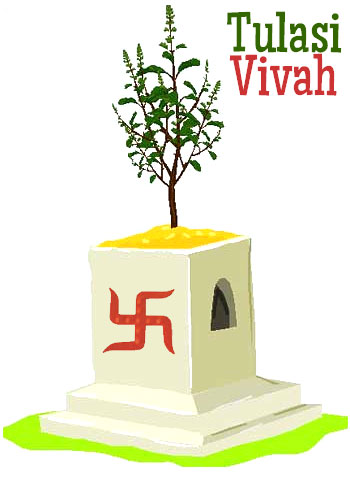A Brief about Tulsi Vivah
India is a land of festivals. Every day is a festival in India. Tulasi vivah is one of them. The occasion has special timings, which in mother tongue is called muhrat and that is believed to be auspicious at any time between the eleventh lunar day of the bright fortnight of the Hindu month Kartik, which in mother tongue is called Prabodhini Ekadashi to the full moon of the month, actually Kartik Poornima, but usually it is performed on the eleventh or the twelfth lunar day. The day varies from region to region according to longitude and latitude.
Tulsi Vivah 2023 on 24 November (Friday)
Story behind Tulsi Vivah
The Tulsi wedding signifies the end of the monsoon and the beginning of the Hindu wedding season. Maa Tulsi is venerated and paid reveration from the bottom of heart as a goddess in Hindu culture and sometimes considered a wife of Vishnu and sometimes with the epithet Vishnupriya who is the beloved of Lord Vishnu. Padma Purana, a scripture which tells about the history of Tulsi Vivah. According to Padma Purana, the Tulsi plant was personified as it was name of a woman who was then called as Vrinda (Brinda) – which is a synonym of Tulsi. She was married to the demon-king, the devil Jalandhar, who due to his piety and devotion and dedication to Vishnu, became invincible. Even Lord Shiva who is popularly known as the destroyer in the Hindu Trinity or community was not able to defeat Jalandhar, thus, he requested Vishnu - the preserver of the Trinity - to find a solution. Vishnu came in the guise of Jalandhar and dodged Vrinda. Her chastity destroyed, Jalandhar lost all his powers and eventually Lord Shiva killed him. Vrinda cursed Lord Vishnu to become black in colour and he would soon loose his beloved wife, Goddess Lakshmi. And actually this came true when Lord Vishnu transformed into the black Shaligram stone (actually a fossil), and when he took his avatar Lord Rama, he soon lost his wife, Goddess Sita as the demon king Ravana kidnapped her. Vrinda then drowned herself in the ocean, and the gods or Vishnu himself transferred her soul to a plant, which was henceforth called as Tulsi. Now, Lord Vishnu eagerly wanted to get back in his original form and for this matter in his next birth married Tulsi on Prabodhini Ekadashi. To commemorate this event, the ceremony of Tulsi Vivah is performed. Another minor legend narrates that Lakshmi slew a demon on this day and remained on earth as the Tulsi plant.
The marriage of Tulsi with Vishnu resembles the traditional Hindu wedding, in Kalyug marriages take place the same way. The ceremony should be conducted at homes and also at temples but nowadays in new customs it take place at halls as well as hotels. Fast is also observed on the day of Tulsi Vivah till evening when the ceremony begins. A mandap, the marriage booth is built around the courtyard of the house where the Tulsi plant is planted. The Tulsi plant is usually planted in centre of the courtyard in a brick plaster called Tulsi vrindavana. It is believed that the soul of Vrinda resides in the plant at night and leaves in the morning. The bride Tulsi is draped with a sari and ornaments including earrings and necklaces. A human paper face with a bindi and nose-ring - may be attached to Tulsi. The groom is a brass image or picture of Vishnu or Krishna or sometimes Balarama or more frequently the Shaligram stone - the symbol of Vishnu. The image is clothed in a dhoti. Both Vishnu and Tulsi are bathed and decorated with flowers and garlands before the wedding. The couple is linked with a cotton thread (mala) in the ceremony.